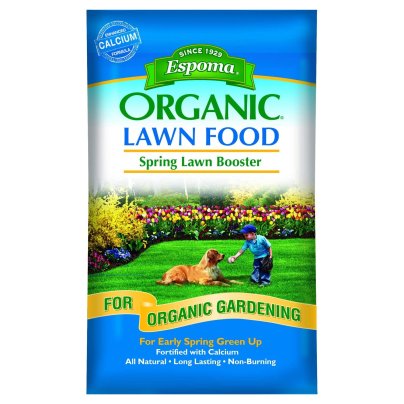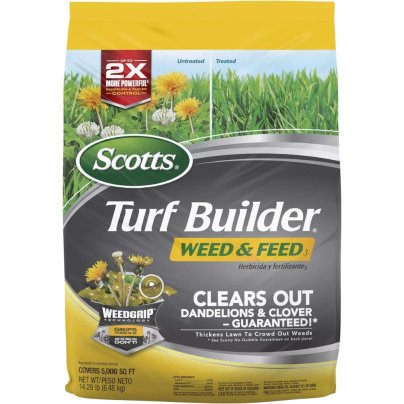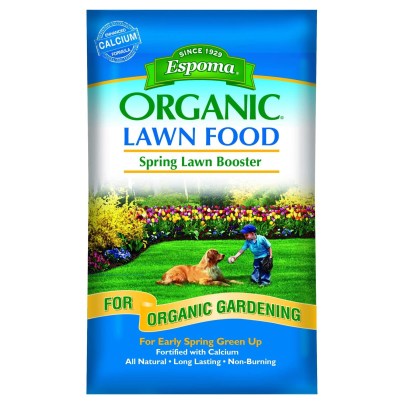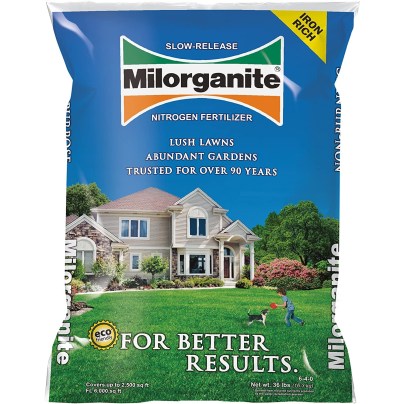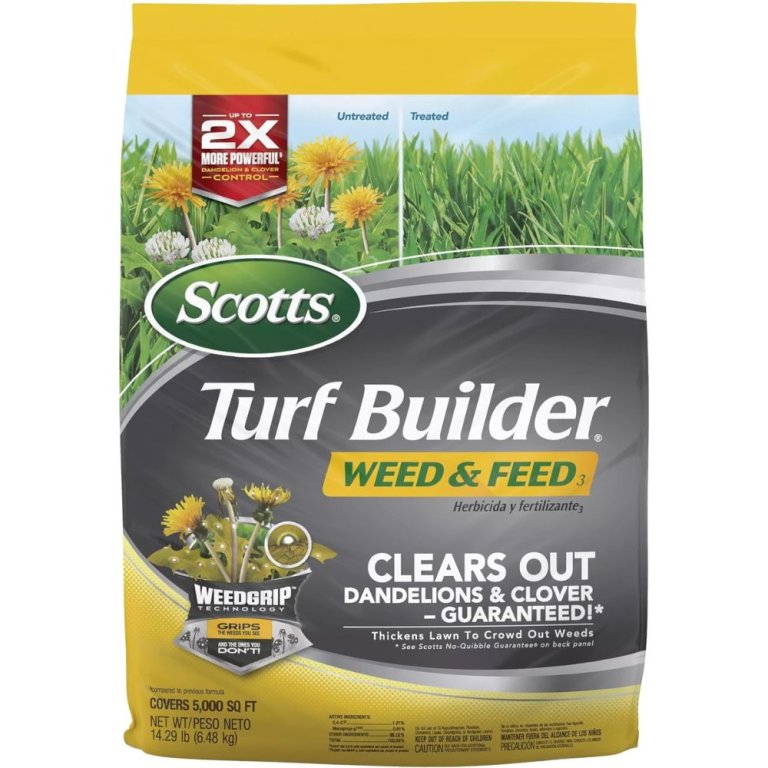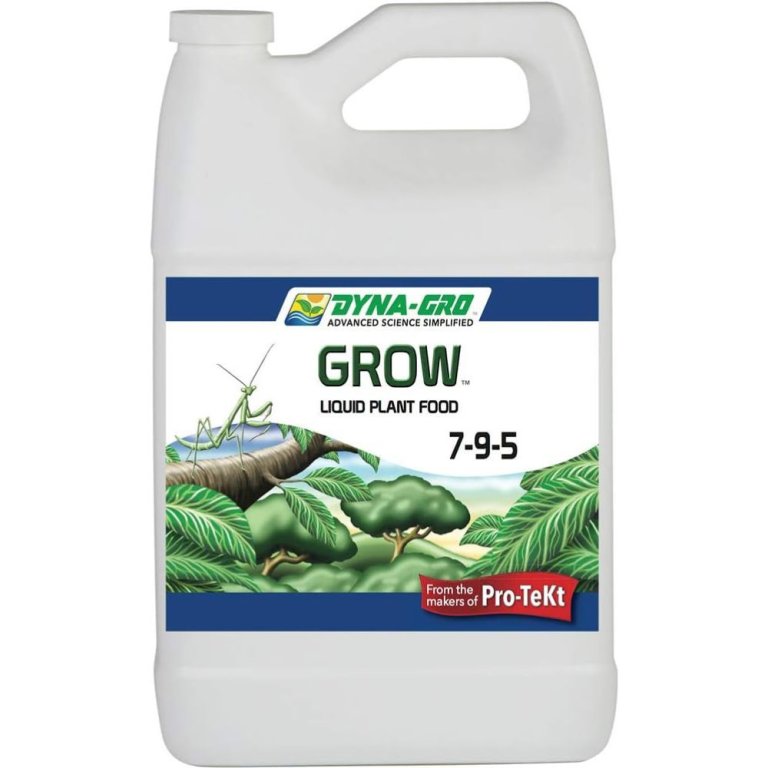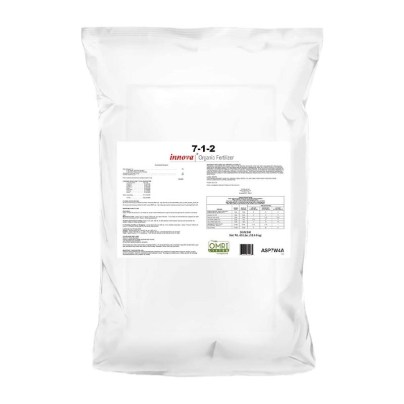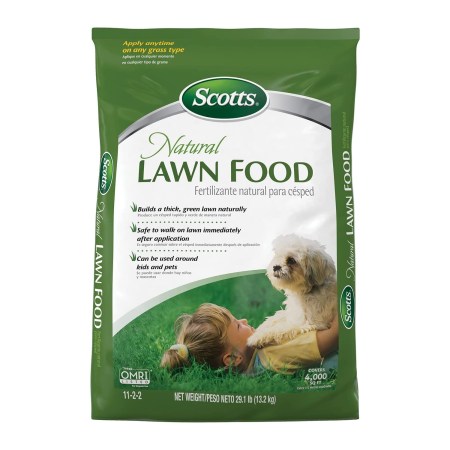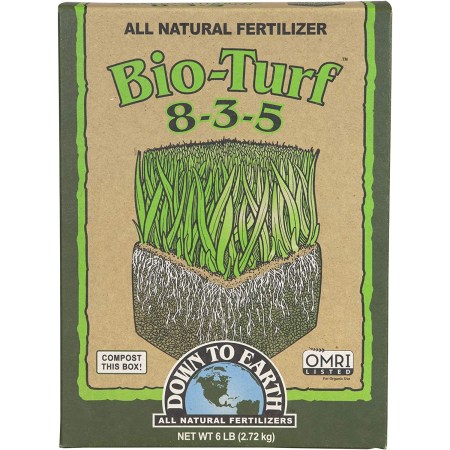
We may earn revenue from the products available on this page and participate in affiliate programs. Learn More ›
Whoever said, “The grass is always greener on the other side,” probably wasn’t using the right stuff. When it comes to keeping a yard in top condition, all that’s really needed is the best lawn fertilizer for the climate and a few dates circled on the calendar.
Once the ideal formula has been determined, simply apply as instructed and follow up as directed on the package. This guide will outline the fertilizer fundamentals and offer reviews of some of the highest-rated products on the market; we vetted and/or tested them hands-on ourselves.
- BEST OVERALL: Espoma EOLB30 Organic Spring Lawn Booster Fertilizer
- BEST BANG FOR THE BUCK: Milorganite 0636 Organic All-Purpose Lawn Fertilizer
- BEST WEED AND FEED: Scotts Turf Builder Weed & Feed
- BEST LIQUID: Dyna-Gro Liquid Plant Food
- BEST ORGANIC: The Andersons Innova 7-1-2 Organic Lawn Fertilizer
- BEST FOR GREENER GRASS: Scotts Natural Lawn Food
- BEST FOR THICKER GRASS: Safer Brand Lawn Restore Natural Lawn Fertilizer
- MOST VERSATILE: Down to Earth Organic Bio-Turf 8-3-5 Lawn Fertilizer
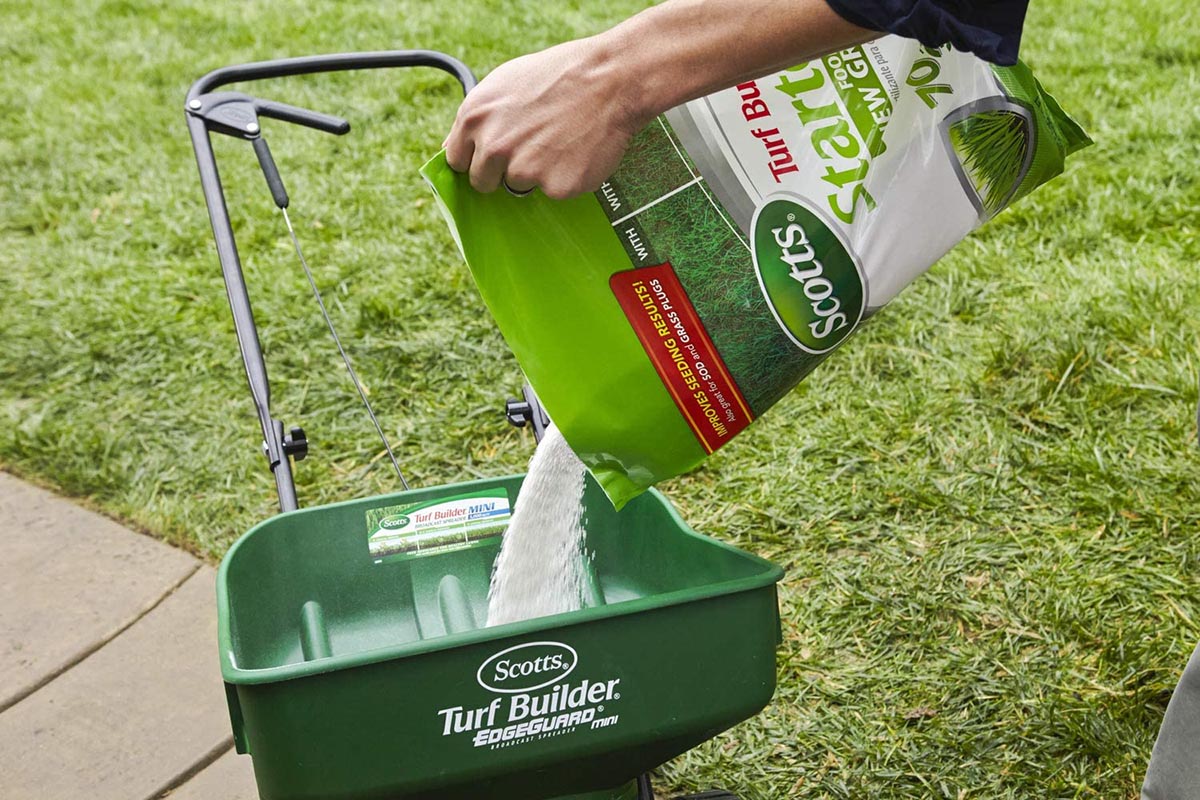
Before You Buy Lawn Fertilizer
With the rise of lawn-care culture over the past century, a stream of science and marketing has arisen promising ”the perfect lawn.” Use caution. While these truly amazing products can support a beautiful, healthy patch of grass, the same products used improperly can kill the grass, make people sick, and aggravate a host of environmental problems.
Before buying and applying lawn fertilizer, find out which kind and how much fertilizer the grass needs. A soil test, either a do-it-yourself kit or a mail-in packet through a local extension service, will provide the information you need. Avoid any temptation to apply more than the test results recommend. Doing so could screw up the soil chemistry, and maybe worse.
How We Chose the Best Lawn Fertilizers
The lawn fertilizer industry is flush with specialty products for every conceivable need. Unique formulations abound for winterization, spring green-up, summer maintenance, weed and feed, lawn starter, northern and southern grass formulas, and so much more. We wanted to cut through the noise and recommend lawn foods that would be broadly useful for the widest range of lawns, including warm and cool-season grasses and acid-loving lawns.
As for formulations, we exclusively featured organic and natural products for a couple of reasons. Organic fertilizers are nonburning, promote healthy soil ecology, minimize nutrient runoff, and provide an extended steady feed. Nonorganic fertilizers can do these things as well, but as a category, organics do so with a high level of consistency from product to product.
Our Top Picks
A good yard fertilizer is necessary when building a strong, healthy lawn. In the reviews ahead, we share more product information about our top picks and why we consider them to be some of the best lawn fertilizers available.
Best Overall
Espoma EOLB30 Organic Spring Lawn Booster Fertilizer
Pros
- Nitrogen-rich fertilizer formula contributes to greener grass
- Formula contains 3 percent calcium to protect against disease
- 30-pound bag covers an area of up to 5,000 square feet
Cons
- Formula doesn’t contain any potassium, so it’s not ideal for centipede or St. Augustine grasses
Product Specs
- NPK ratio: 8-0-0
- Weight: 30 pounds
- Coverage: 5,000 square feet
Those looking to make their lawns look best for spring will want to consider this option from Espoma. With an NPK ratio of 8-0-0, it’s designed to make lawns look their best at the beginning of the season. (For an in-depth description of NPK, please see the Nutrients section after the product descriptions.) The formula contains feather meal and pasteurized poultry manure, which combine to provide a healthy dose of nitrogen for greener grass. The product comes in a 30-pound bag and can be used on newly sodded or established lawns.
The manufacturer recommends using this fertilizer in February, March, or April for cool-season grasses and in January or February for warm-season grasses. It’s important to note that this formula doesn’t contain any potassium, so it’s not a great choice for those with centipede grass or St. Augustine grass.
Get the Espoma lawn fertilizer at Amazon, Ace Hardware, or Walmart.
BEST BANG FOR THE BUCK
Milorganite 0636 Organic All-Purpose Lawn Fertilizer
Pros
- Formula is fortified with iron for a dark green lawn
- Recycled formula is ideal for environmentally conscious users
- Brand has a long history of top-notch performance
- Each application lasts for 10 weeks; can be applied at any time of the year
Cons
- Formula contains phosphorus, which many soils do not need
Product Specs
- NPK ratio: 6-4-0
- Weight: 32 pounds
- Coverage: 2,500 square feet
Milorganite has been a staple in the yard fertilizer industry since its release in the 1920s. This recycled lawn food is derived from heat-treated, nutrient-rich microbes that filter and process organic matter in municipal wastewater. This option is also a slow-release fertilizer that can be applied to a lawn at any time of the year and is suitable for areas where droughts are common.
The fertilizer boasts a 6-4-0 NPK analysis, with 2.5 percent iron promoting deep greening. It can also be used on plants, shrubs, trees, and flowers, making it very versatile. One application feeds for 10 weeks and does not need to be watered in. The 32-pound bag covers 2,500 square feet.
Get the Milorganite lawn fertilizer at Amazon, Lowe’s, or Walmart.
BEST WEED AND FEED
Scotts Turf Builder Weed & Feed
Pros
- Removes common broadleaf weed varieties while feeding and promoting lush growth
- One 14.29-pound bag is capable of covering over 5,000 square feet; can be used for a wide range of applications
- Affordable price point compared to some other lawn fertilizers available
Cons
- Requires a spreader for proper application on a lawn
- Not suitable for use on warm-season grass varieties
- Contains some chemicals that can be harsh on the environment or wildlife
Product Specs
- NPK ratio: 28-0-3
- Weight: 14.29 pounds
- Coverage: 5,000 square feet
For all-around nutrition for your grass, trust Scotts Turf Builder Weed & Feed. This lawn fertilizer and weed killer removes common broadleaf lawn weeds with the help of its WeedGrip technology while thickening the grass itself. The 14.29-pound bag of weed and feed covers over 5,000 square feet, making it ideal for large lawns or multiple applications. Be advised that this product will need to be applied when the temperature outside is between 60 and 90 degrees Fahrenheit, and the lawn should be damp upon application with a spreader.
This granular weed and feed from Scotts works on most grass varieties including fescue, Kentucky bluegrass, Bahia, ryegrass, centipede, Bermuda, and zoysia. However, it is not recommended for warm-season grass varieties like St. Augustine, carpet, and dichondra.
Get the Scotts Turf Builder lawn fertilizer at Amazon, Lowe’s, The Home Depot (11.32-pound bag), or Target (11.57-pound bag).
BEST LIQUID
Dyna-Gro Liquid Plant Food
Pros
- Made with over 16 essential nutrients for aiding plant growth; rich in nitrogen and phosphorus
- Ultra-concentrated formula lasts for long-term use; usually requires ½ or ¼ teaspoon per gallon
- Suitable for use on lawns and any other plant varieties for maximum versatility
Cons
- Requires dilution before use; may be tricky to find the dilution for some plants or lawn varieties
Product Specs
- NPK ratio: 7-9-5
- Weight: 2 pounds
- Coverage: Unlisted
Liquid fertilizer is an effective solution for dry or patchy lawns, and it’s easier to apply than some other types of fertilizers on the market. This option from Dyna-Gro is no exception. Its formula is made with a 7-9-5 NPK ratio and includes rich micronutrients like calcium, magnesium, boron, cobalt, chlorine, manganese, iron, molybdenum, zinc, and sodium and is also high in nitrogen and phosphorus.
Liquid lawn fertilizers are ideal for grass growth, but this Dyna-Gro option can also be used on indoor or outdoor plants, hydroponics, and rocky soil varieties. As this is a super concentrate, the dilution depends on the plant variety, with most applications requiring ½ or ¼ teaspoon per gallon of water. However, the brand provides exact ratios for use on different plant varieties and can be applied with a sprayer.
What our tester says: Mark Wolfe, Bob Vila commerce writer, notes in The Best Fertilizer for Indoor Plants that: “we liked that this fertilizer contained a well-rounded balance of micronutrients in addition to the NPK content. The plants produced a healthy flush of new foliage with no symptoms of stress, disease, or insect infestation. We also noted that the manufacturer offers recommendations for different application rates to fit a variety of growing situations.”
Get the Dyna-Gro lawn fertilizer at Amazon or Greenhouse Megastore.
BEST ORGANIC
The Andersons Innova 7-1-2 Organic Lawn Fertilizer
Pros
- Low quantity of dust granules makes this product easier to apply
- Entirely plant-based and contains no animal parts or byproducts
- Nonburning formula ensures that users can avoid overapplication
Cons
- Not readily available from all major retailers and may be difficult to find in person
Product Specs
- NPK ratio: 7-1-2
- Weight: 40 pounds
- Coverage: 11,000 square feet
This high-nitrogen fertilizer feeds lawns at a slow, steady pace with a 7-1-2 NPK content and amino acids. The plant-based formula does not contain worrisome biosolids, manures, recycled waste, or animal parts. The nonburning granules prevent damage and are engineered for low dust so that they are easy to apply and won’t trigger sneezing. The 40-pound bag feeds up to 11,000 square feet of lawn.
Innova 7-1-2 is Organic Materials Review Institute (OMRI) listed for use in certified organic operations and has a low-runoff formula that is safe to apply near waterways. It stimulates a healthy soil ecosystem by supplying easily digestible carbon to fuel soil microbes. This product is as close as it comes to the organic ideal.
Get The Andersons lawn fertilizer at Amazon, The Home Depot, or Walmart.
BEST FOR GREENER GRASS
Scotts Natural Lawn Food
Pros
- Scotts fertilizer is gentle enough to use on freshly seeded or sodded grass
- Provides a balance of phosphorus and potassium along with nitrogen
- Safe to walk on the lawn immediately after fertilizer application
Cons
- Some users report that their dogs are attracted to the scent of this fertilizer
Product Specs
- NPK ratio: 11-2-2
- Weight: 29.1 pounds
- Coverage: 4,000 square feet
Those looking for a deep, dark green color for their grass will want to consider this all-natural fertilizer from Scotts, an established brand in lawn care. When starting a new and beautiful lawn, whether by seed, sod, or plugs, the right soil nutrition is essential. Scotts Natural Lawn food delivers a small boost of phosphorus for rapid root establishment and a strong dose of nitrogen for healthy foliage growth. The 29.1-pound bag feeds 4,000 square feet of lawn.
It can be applied with either a drop or a broadcast spreader and should be watered following application. You can also save water by applying the fertilizer right before rain is forecast.
Get the Scotts natural lawn fertilizer at Amazon, Ace Hardware, Tractor Supply Co., or Walmart.
BEST FOR THICKER GRASS
Safer Brand Lawn Restore Natural Lawn Fertilizer
Pros
- Fertilizer produces results in just a few days, unlike many all-natural formulas
- Granular formula makes for easy application
- Formula doesn’t include phosphorus, which most lawns in the U.S. do not need.
Cons
- Though this fertilizer is made from natural ingredients, it is not certified organic
Product Specs
- NPK ratio: 9-0-2
- Weight: 20 pounds
- Coverage: 5,000 square feet
Difficult growing conditions can cause a snowball effect where declining grass leads to depleted soil. When that happens, it takes a combined effort to turn things around. First, identify and address the origin of the problem—often fungus, insects, or competition from a growing tree—and then treat the area with Safer Brand Lawn Restore fertilizer. The blend of organic plant food ingredients is designed to increase soil biological activity while it nourishes the grass. The 20-pound bag treats 5,000 square feet of lawn.
Safer Brand Lawn Restore is derived from natural fertilizer ingredients including feather meal, soybean meal, blood meal, alfalfa meal, molasses, and sulfate of potash. The nutrients are not water-soluble but instead are released by the action of soil-building microbes. It builds soil as it feeds plants while protecting the environment from the effects of nutrient runoff.
Get the Safer Brand lawn fertilizer at Amazon, Ace Hardware, Tractor Supply Co., or Walmart.
MOST VERSATILE
Down to Earth Organic Bio-Turf 8-3-5 Lawn Fertilizer
Pros
- Inclusion of potassium protects against drought and temperature changes
- Suitable for all grass types; can also feed vegetable gardens
- High nitrogen level is designed to promote greener grass
Cons
- Not readily available from many major retailers
Product Specs
- NPK ratio: 8-3-5
- Weight: 6 pounds
- Coverage: 1,000 square feet
This Down to Earth fertilizer has an NPK ratio of 8-3-5 with a higher proportion of nitrogen to promote early-season lawn growth; the potassium content helps alleviate seasonal stress caused by temperature changes and drought. Its composition includes hydrolyzed feather meal, blood meal, meat meal, bone meal, and langbeinite, making it a highly versatile product that can even be used to feed crops such as corn, tomatoes, leafy greens, and lawns.
This fertilizer is approved for use in organic gardening by the OMRI. The 6-pound package can nourish a lawn of up to 1,000 square feet, and larger bags are also available.
Get the Down to Earth lawn fertilizer at Amazon or Walmart (50-pound bag).
Or, DIY Your Own Lawn Fertilizer
Making your own organic lawn fertilizer is a cost-effective and eco-friendly way to keep your lawn healthy. To make a basic DIY organic fertilizer, mix equal parts of bone meal, blood meal, and kelp meal in a large container. All of these ingredients can be found online or at a well-stocked garden supply store.
For every 100 square feet of lawn, spread around 5 pounds of the mixture evenly. The bone meal provides phosphorus for root growth, the blood meal adds nitrogen for leaf development, and the kelp meal contains a range of trace minerals that improve soil health. Water your lawn well after applying the fertilizer to help the nutrients penetrate the soil. Alternatively, you can also use compost tea, made by soaking compost in water for a few days and using the liquid as a fertilizer.
Jump to Our Top Picks
Our Verdict
Since potent, fast-acting lawn food comes with the inherent risks of burning the lawn or polluting the environment, we recommend taking a natural approach. There are other common lawn fertilizer options on the market, including Scotts Turf Builder and Pennington UltraGreen Weed & Feed. However, they do not meet our sustainability guidelines and are not recommended in our top picks due to their potentially harmful ingredients and negative impact on the environment.
What to Consider When Choosing Lawn Fertilizer
Shopping for fertilizer for grass is anything but intuitive. Just ahead, find out more about what a lawn really needs and the best way to provide lawn fertilization.
Nutrients
Three digits are printed on all lawn fertilizer labels. Known as the NPK ratio, the numbers stand for the percentage of basic nutrients (N for nitrogen, P for phosphorus, K for potassium) the fertilizer contains. If a fertilizer’s NPK ratio is 12-0-10, for example, it contains 12 percent nitrogen, no phosphorus, and 10 percent potassium.
Generally speaking, nitrogen helps plants stay green, phosphorus promotes root growth, and potassium guards against drought and disease. Depending on the type of turf, the soil’s native chemistry, and the climate, one combination will be better than others. The best way to determine the exact needs for a lawn is by beginning the fertilization program with a soil test and then finding the fertilizer that best fills in what’s missing.
Organic vs. Synthetic
Once the best NPK number has been determined, it’s time to decide between a synthetic or organic fertilizer.
- Synthetic varieties are engineered from minerals, gases, and even waste with the intent of delivering fast results—sometimes within a matter of days. The downsides to synthetic fertilizers are their reputation for “burning” (i.e., killing) grass if used in too heavy-handed a manner. They can also pose environmental damage and health risks if they leach into the local water supply, which is why we opted not to include any synthetic fertilizers among our recommendations.
- Organic fertilizers are made from living organisms—anything from cottonseed or peat moss to bat guano and blood or bone meal. They can take a bit longer to work their magic—it’s often a few weeks before results are visible. Although they require a bit of patience, the environmental and health risks are low.
Formula
There are two fertilizer formulas: liquid and granular.
- Liquid fertilizer, which comes as either a fluid (requiring dilution in water) or a powder (to which water should be added), tends to require more frequent application than granular. It can also pose an environmental risk if it contaminates the local water supply in large amounts, leaking lead, cadmium, and arsenic via storm drain runoff and causing algae blooms as well as long-term public health risks. That said, it’s an effective way to see quick results, so it’s only recommended when truly rapid results are needed.
- Granular fertilizer tends to operate in a slow-release fashion, taking up to a month or longer to deliver results but requiring less frequent follow-up. It also poses far less of a health risk overall, so it’s generally a better option for those who aren’t in a major hurry.
Fast vs. Slow Release
The decision between fast- and slow-release fertilizer formulas comes down to grass metabolism. Two instances when fast-release lawn food can be beneficia l are during early spring and when planting a new lawn. A quick dose of nitrogen fertilizer helps overwintered grass produce new leaves early in the season, which helps it to grow more roots faster. Similarly, quick-release lawn starter can help young grass seedlings or newly installed sod become established more quickly.
On the other hand, slow-release lawn food is best for long-term maintenance. This type of plant food ensures a steady supply of the right nutrients throughout the season. Slow-release grass fertilizer is like a meal for the lawn, but fast release is more like a snack.
Grass Type
Most warm- and cool-season grasses share many of the same nutritional requirements. They thrive on a steady supply of nitrogen throughout the growing season to support fast-growing foliage. Phosphorus may not be necessary and should only be applied based on the guidance of a soil test. Potassium needs to be replenished regularly to support drought resistance and overall health. The usual healthy ratio is on the order of 4-0-2.
Two grass types that buck this trend are centipede and St. Augustine grasses. These warm-climate species consume greater amounts of potassium than other grasses. They need roughly equal amounts of nitrogen and potassium but near-zero phosphorus. Look for 15-0-15, or something similar, for these grasses.
Tips for Using Lawn Fertilizer
The first and most important step in fertilizing the lawn is to find out what the lawn is lacking. By testing the soil chemistry, nutrient imbalances that can be corrected with targeted applications become apparent. Otherwise, you’ll risk over applying nutrients that are already present or neglecting a nutrient deficiency. Once the test results are in hand, then match the results to the best available fertilizer.
- For even coverage, apply with a fertilizer spreader.
- With the spreader calibrated at half the recommended rate, apply in parallel lines going one direction, then again in lines running perpendicular to the first application.
- Avoid broadcasting fertilizer onto pavement or landscape beds.
- Blow or sweep fertilizer off of pavement immediately after application.
- Apply fertilizer ahead of rain or run sprinklers within 24 hours after application.
FAQs
Find answers to the most commonly asked questions about lawn fertilizer below.
For cool-season grasses like tall fescue and Kentucky bluegrass, fertilize when the soil reaches 55 degrees Fahrenheit or when it has begun active growth. For warm-season grasses like Bermuda grass, zoysia, and centipede grass, fertilize when the grass has turned at least 50 percent green after the winter months.
An ideal lawn fertilizer schedule depends on the fertilizer formula, type of grass, climate, weather, and soil nutrient levels. Overfertilization is a far greater risk to the lawn itself and to the environment than not fertilizing. With organic lawn fertilizers, two applications are typically adequate, unless directed otherwise by soil-test results.
The best way to know what your lawn needs is to test the soil. Avoid using balanced analysis plant foods like 10-10-10 or 15-15-15 fertilizer for lawns. Although these products hold some of the nutrients that grass needs, they do not offer them in the right amounts. Instead, use lawn fertilizer with an analysis that equates a 4-0-2 or 4-1-2 ratio.
Natural lawn fertilizers are made with animal and/or plant byproducts as the nutrient source rather than mined minerals or chemical products. The nutrient analysis of natural fertilizer tends to be lower than that of conventional fertilizer, but natural products offer additional benefits such as increasing soil organic matter, boosting beneficial soil microbes, providing for an extended feed, and minimizing nutrient runoff.
